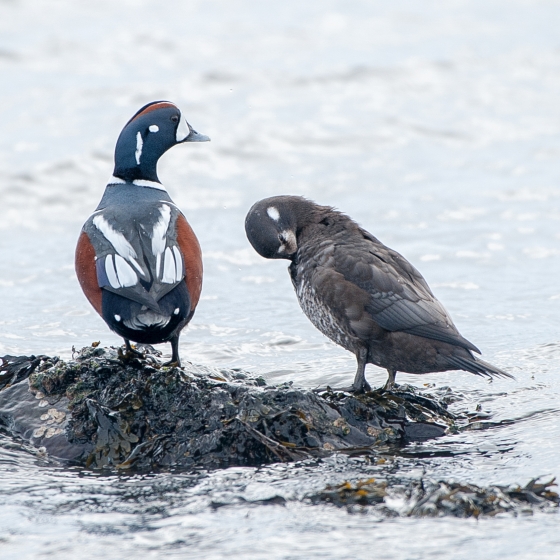Harlequin Duck

Introduction
Males of this small duck are unmistakable with their blue plumage. Sadly, this is only an extremely rare winter visitor to northern Britain from the northernmost reaches of Europe.
When engaged in behavioural interactions, the Harlequin Duck gives a series of distinctly unduck-like squeaks, the source of one of its local names in Canada: 'sea mouse'.

Key Stats
Status and Trends
Conservation Status
Population Size
Population Change
Population trends of this scarce species are not routinely monitored.
Distribution
This vagrant is too rarely reported to map distribution. Recent records have been in Scotland.
European Distribution Map
Distribution Change
This vagrant is too rarely reported to map distribution change.
Seasonality
This species has been too rarely reported to BirdTrack during 2011–22 to properly assess seasonality.
Movement
Britain & Ireland movement
Biology
Survival and Longevity
Survival is shown as the proportion of birds surviving from one year to the next and is derived from bird ringing data. It can also be used to estimate how long birds typically live.
Classification, names and codes
Classification and Codes
- Order: Anseriformes
- Family: Anatidae
- Scientific name: Histrionicus histrionicus
- Authority: Linnaeus, 1758
- BTO 2-letter code: HQ
- BTO 5-letter code: HARDU
- Euring code number: 2110
Alternate species names
- Catalan: ànec arlequí
- Czech: kacka strakatá
- Danish: Strømand
- Dutch: Harlekijneend
- Estonian: kärestikuaul
- Finnish: virta-alli
- French: Arlequin plongeur
- German: Kragenente
- Hungarian: tarka réce
- Icelandic: Straumönd
- Italian: Moretta arlecchino
- Latvian: arlekinpile
- Lithuanian: islandine antis
- Norwegian: Harlekinand
- Polish: kamieniuszka
- Portuguese: pato-arlequim
- Slovak: kamenárka strakatá
- Slovenian: harlekinka
- Spanish: Pato arlequín
- Swedish: strömand

